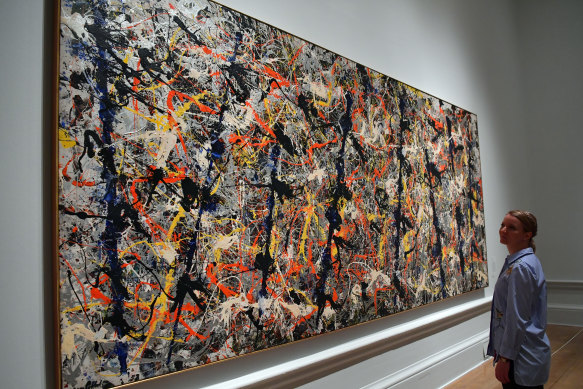Cultural institutions including the National Gallery of Australia and the National Library are poised to receive a funding lifeline in the May budget after the federal government signalled it would not let them run out of money.
Services including the popular Trove online portal to more than 6 billion digital items, the National Portrait Gallery and the National Maritime Museum, which all faced an end to key funding sources on June 30, are also expected to have their financial futures assured.
The National Gallery, home to Jackson Pollock’s Blue Poles, is expected to get a vital financial lifeline in the May budget.Credit:Carl Court/Getty
Finance Minister Katy Gallagher on Monday revealed the government would have to find billions of dollars to cover a series of “fiscal cliffs” caused by so-called “zombie” programs expected to continue but without their funding baked into the budget forward estimates. The government found $4.1 billion worth of zombie programs in the October budget.
Key collecting institutions, many of which suffered funding cuts under the previous government’s mandated public sector efficiency dividends, have been warning of their plight for months.
The National Gallery revealed earlier this month that 12 per cent of its staff are being paid by philanthropists because growing costs and budget cuts left the institution unable to afford their salaries.
It needs $265 million over the next 10 years to waterproof and remediate its 40-year-old building as lifts and escalators, electric wiring, and air conditioners come to the extreme end of their working life.
The National Library signalled without additional and secure funding, the Trove portal would have to cease operation from July 1. It attracts more than 22 million visits a year and is one of the most popular Australian government websites in the world.
Gallagher said a string of programs, from the arts to the Brisbane Olympics, had been left as budget “booby traps” that were all poised to go off from July 1.
“Australians were tricked by the former Coalition government into thinking that programs that they rely upon or that support communities across the country were being properly funded,” she said.
“A closer inspection of the books has revealed a budget full of fiscal cliffs, half-funded measures and booby traps, which we will need to clean up.”
Arts Minister Tony Burke said the previous government had deliberately run-down the nation’s most important collecting institutions including the National Gallery.
“I don’t know if they thought maybe at the National Gallery you hold the roof up with Blue Poles or maybe it would be like Night At The Museum and all of the exhibits would start running around and fixing the building themselves every night,” he said.
Treasurer Jim Chalmers said there would be money in the budget to protect those institutions facing an end to their funding in the 2023-24 financial year.
“This will cost billions of dollars to fix in May – one of the main pressures on the budget that we need to deal with,” he said.
Gallagher said the programs or agencies without funding that needed to be kept going included the Australian Radioactive Waste Agency, which has no funding confirmed in the budget beyond mid-December.
Funding drops significantly for the National Emergency Management Agency, the eSafety commissioner, the adult public health program and the My Health Record system, which is used by 23 million people.
Chalmers is expected to announce a better-than-forecast budget deficit for the current financial year and 2023-24 due, in part due to strong commodity prices and the high level of employment and wages growth across the country.
Cut through the noise of federal politics with news, views and expert analysis from Jacqueline Maley. Subscribers can sign up to our weekly Inside Politics newsletter here.
Most Viewed in Politics
From our partners
Source: Read Full Article
